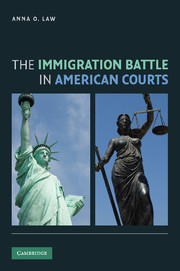Book contents
- Frontmatter
- Contents
- List of Tables and Figures
- Acknowledgments
- 1 Introduction
- 2 How Do We Know What We Know? Data, Methods, and Initial Findings
- 3 The Rise of Two Courts with Differentiated Functions
- 4 Interstitial Policy Making in the U.S. Courts of Appeals
- 5 Institutional Growth and Innovation: The Ninth Circuit Court of Appeals and Immigration
- 6 Continuity Amid Change: The Federal Courts' Commitment to Due Process
- 7 Conclusion
- Appendix A Further Elaboration of Case Selection Methods
- Appendix B Further Elaboration on the Search for Modes of Legal Reasoning
- Appendix C Numerical Codes for Modes of Legal Reasoning
- Appendix D Interview Questions
- Index
- References
1 - Introduction
Published online by Cambridge University Press: 04 August 2010
- Frontmatter
- Contents
- List of Tables and Figures
- Acknowledgments
- 1 Introduction
- 2 How Do We Know What We Know? Data, Methods, and Initial Findings
- 3 The Rise of Two Courts with Differentiated Functions
- 4 Interstitial Policy Making in the U.S. Courts of Appeals
- 5 Institutional Growth and Innovation: The Ninth Circuit Court of Appeals and Immigration
- 6 Continuity Amid Change: The Federal Courts' Commitment to Due Process
- 7 Conclusion
- Appendix A Further Elaboration of Case Selection Methods
- Appendix B Further Elaboration on the Search for Modes of Legal Reasoning
- Appendix C Numerical Codes for Modes of Legal Reasoning
- Appendix D Interview Questions
- Index
- References
Summary
The Statue of Liberty in New York Harbor has represented hope and freedom for many generations of immigrants. The image of Lady Justice, with her blindfold and scales, that is found in almost every courtroom of the United States has inspired many litigants' and jurists' hopes for an equitable meting out of justice. This book examines the intersection of two traditions in U.S. life and politics that are represented by those ubiquitous images: the country's legacy as a nation of immigrants and its commitment to provide equal treatment under the law. In this nation of immigrants, how have the two highest federal courts, the Supreme Court of the United States and the U.S. Courts of Appeals, treated aliens' petitions to enter or to remain in this country?
The U.S. Supreme Court has a dubious track record when it comes to immigration. Historian Leonard Dinnerstein summarized the Court's behavior in immigration cases as follows: “In the land that proudly proclaims its immigration heritage, the Supreme Court, over the years, has consistently allowed Congress and the executive branch of the federal government the right to admit, exclude, or banish non-citizens on any basis they chose including race, sex, and ideology.” What explains this situation? For the Supreme Court to afford this degree of latitude and deference to the elected branches is unusual because the Court has in many other areas of law, such as criminal law, not hesitated to challenge or contradict the two other branches of government.
- Type
- Chapter
- Information
- The Immigration Battle in American Courts , pp. 1 - 18Publisher: Cambridge University PressPrint publication year: 2010



